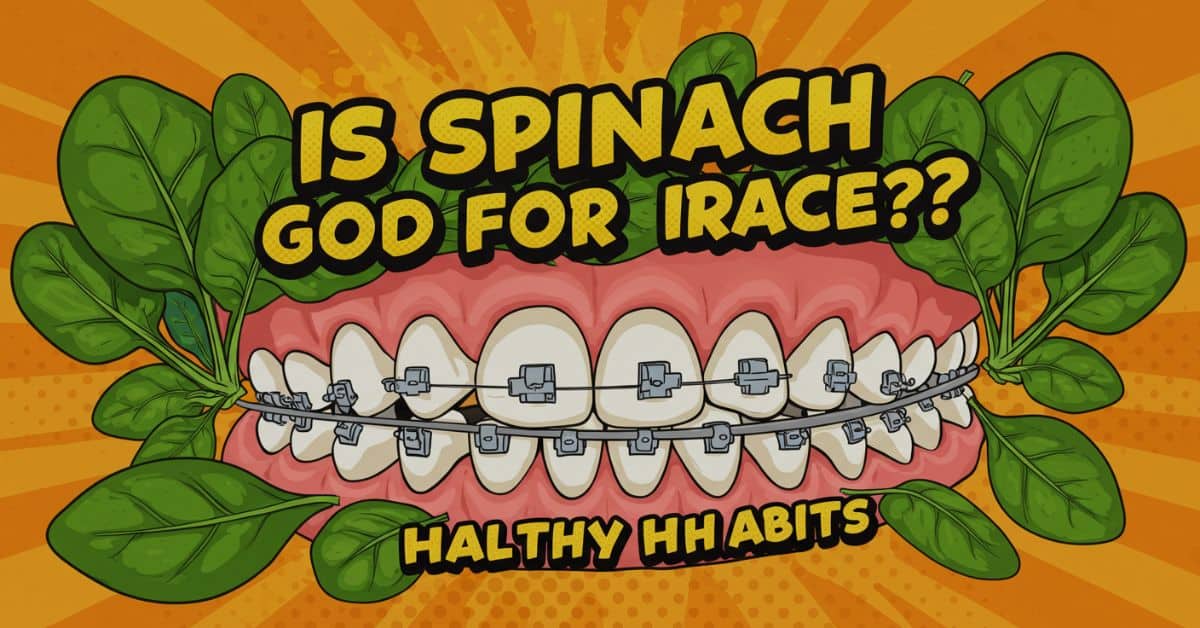Wearing braces brings a lot of changes to your daily life, especially your diet. Certain foods can cause issues with your orthodontic treatment, while others can provide essential nutrients to support your oral health. A common question that arises is, “Is spinach good for braces?” This leafy green is often praised for its health benefits, but how does it fare when braces are involved? In this comprehensive guide, we’ll explore the benefits and precautions of eating spinach while wearing braces.
Contents
- 1 Understanding Braces and Dietary Needs
- 2 Nutritional Value of Spinach
- 3 Is Spinach Good for Braces? A Closer Look
- 4 Advantages of Eating Spinach During Orthodontic Treatment
- 5 Potential Downsides of Eating Spinach With Braces
- 6 Best Ways to Eat Spinach with Braces
- 7 Delicious Braces-Friendly Spinach Recipes
- 8 Spinach vs. Other Leafy Greens for Braces Wearers
- 9 How Spinach Affects Oral Health with Braces
- 10 Oral Hygiene Tips After Eating Spinach
- 11 Expert Opinions on Eating Spinach With Braces
- 12 Frequently Asked Questions (FAQs)
- 12.1 Can I eat raw spinach with braces?
- 12.2 Is spinach dip okay to eat with braces?
- 12.3 How often can I eat spinach with braces?
- 12.4 Does spinach stain braces or teeth?
- 12.5 What should I do if spinach gets stuck in my braces?
- 12.6 Can spinach help strengthen my teeth while wearing braces?
- 12.7 Is baby spinach better for braces than mature spinach?
- 12.8 Are there any allergic reactions to spinach I should be aware of?
- 13 Final Thoughts
- 14 Additional Resources
Understanding Braces and Dietary Needs
Braces are orthodontic devices used to correct misaligned teeth, bite issues, and jaw positioning. While they are effective, they come with dietary restrictions to avoid damaging brackets, wires, or causing discomfort. A braces-friendly diet should focus on soft, nutrient-rich foods that are easy to chew and won’t stick to your orthodontic appliances.
Why Diet Matters With Braces
- Prevents damage to braces: Hard or sticky foods can break wires or dislodge brackets.
- Reduces discomfort: Softer foods ease pain during adjustment periods.
- Supports oral hygiene: Clean-eating habits reduce plaque buildup.
- Boosts healing and bone health: Nutrient-rich foods help maintain strong teeth and gums.
Nutritional Value of Spinach
Spinach is a superfood packed with nutrients, making it a popular choice for health-conscious individuals. Its soft texture and high vitamin content make it an appealing option for those with braces.
Key Nutrients in Spinach
- Calcium: Strengthens teeth and bones.
- Iron: Promotes healthy blood circulation, supporting tissue repair.
- Magnesium: Important for bone health and muscle function.
- Vitamins A, C, and K: Boost immunity, improve gum health, and promote healing.
- Folate: Essential for cell repair and regeneration.
Is Spinach Good for Braces? A Closer Look
The answer to the question, “Is spinach good for braces?” is generally yes, but with some considerations. Spinach offers a wealth of nutritional benefits and has a soft texture when cooked, making it safe and beneficial for most braces wearers.
Advantages of Eating Spinach During Orthodontic Treatment
1. Soft Texture When Cooked
Cooked spinach becomes tender and easy to chew, reducing the risk of damaging your braces.
2. Rich in Calcium and Magnesium
These minerals support healthy teeth and bone development, which is crucial during orthodontic treatment.
3. Supports Gum Health
Vitamin C and antioxidants in spinach promote strong, healthy gums, reducing inflammation and bleeding.
4. Low in Sugar and Acidity
Unlike sugary snacks and acidic fruits, spinach is not harmful to your tooth enamel.
5. Easy to Incorporate into Meals
Spinach can be blended into smoothies, added to soups, or used in soft omelets—all of which are braces-friendly meals.
6. Promotes Faster Healing
Spinach’s nutrient-dense profile supports cell regeneration, which can be beneficial for healing during adjustments.
Potential Downsides of Eating Spinach With Braces
While spinach is generally safe, there are a few things to watch out for:
1. Stringy Texture in Raw Spinach
Raw spinach can sometimes get stuck between braces or under wires, making cleaning difficult.
2. Oxalate Content
Oxalates, which are found in spinach, may prevent calcium from being absorbed. Moderation is key.
3. Thorough Cleaning is Required
Spinach can cling to braces, especially in crevices. Be sure to rinse and brush thoroughly after eating.
4. Avoid Tough or Fibrous Stems
Remove stems from raw spinach, as they can be chewy and potentially damage brackets.
Best Ways to Eat Spinach with Braces
To make spinach a safe and beneficial part of your braces-friendly diet, consider these tips:
- Opt for cooked spinach: Sauté, steam, or boil spinach to soften its texture.
- Blend into smoothies: Raw spinach blends well with fruits and yogurt.
- Chop finely: Smaller pieces are less likely to get stuck in braces.
- Use in soups and stews: These dishes are soft, warm, and easy to chew.
- Pair with calcium-rich foods: Helps balance out oxalate content.
Delicious Braces-Friendly Spinach Recipes
1. Spinach and Ricotta Stuffed Shells
Soft pasta shells filled with cooked spinach and ricotta make for a soothing, nutritious meal.
2. Spinach Smoothie
Blend spinach with banana, yogurt, and a splash of almond milk for a tasty and easy-to-drink treat.
3. Creamed Spinach
A creamy, soft side dish that pairs well with mashed potatoes or soft proteins like scrambled eggs.
4. Spinach and Egg Omelet
Whisked eggs with finely chopped spinach make a quick and healthy breakfast.
Spinach vs. Other Leafy Greens for Braces Wearers
Spinach isn’t the only green you can enjoy with braces. Here’s how it compares:
| Leafy Green | Texture When Cooked | Nutritional Value | Braces-Friendly |
|---|---|---|---|
| Spinach | Very soft | High | Yes |
| Kale | Tougher | Very high | Yes (if cooked well) |
| Swiss Chard | Soft when cooked | High | Yes |
| Collard Greens | Needs longer cooking | High | Yes |
| Romaine Lettuce | Crunchy raw | Moderate | In moderation |
How Spinach Affects Oral Health with Braces
Strengthening Enamel
Spinach contains calcium and phosphorus, which are vital for enamel remineralization.
Gum Health Support
Anti-inflammatory properties of spinach help reduce gum swelling and sensitivity.
Immune Support During Braces
Vitamin A and C in spinach strengthen the immune response, helping prevent infections.
Oral Hygiene Tips After Eating Spinach
Maintaining excellent oral hygiene is essential with braces. Here’s how to keep your teeth clean after eating spinach:
- Rinse with water: Dislodge any leftover pieces.
- Brush thoroughly: Use a soft-bristled toothbrush and fluoride toothpaste.
- Use an interdental brush: Reaches between brackets and wires.
- Floss daily: Use floss threaders or orthodontic flossers.
- Mouthwash: Antibacterial mouthwash helps keep your mouth fresh.
Expert Opinions on Eating Spinach With Braces
Most orthodontists agree that spinach is safe for braces wearers, especially when cooked. According to Dr. Anita Rao, DDS:
“Spinach is a nutrient-dense, braces-safe food. Just make sure to cook it well and maintain proper hygiene after meals.”
Frequently Asked Questions (FAQs)
Can I eat raw spinach with braces?
Yes, but it’s best in moderation. Raw spinach can get caught in your braces. If you eat it raw, chop it finely and rinse your mouth after.
Is spinach dip okay to eat with braces?
Generally, yes—especially if it’s creamy and soft. Avoid dips with hard bread or chips.
How often can I eat spinach with braces?
Spinach is safe to eat regularly. However, balance it with other foods to avoid overconsumption of oxalates.
Does spinach stain braces or teeth?
Spinach does not typically stain braces or teeth, but thorough brushing after meals is always recommended.
What should I do if spinach gets stuck in my braces?
Use an interdental brush or rinse with water. Brush and floss if needed to remove any remaining bits.
Can spinach help strengthen my teeth while wearing braces?
Yes, the calcium and magnesium in spinach contribute to stronger teeth and bones, which is beneficial during orthodontic treatment.
Is baby spinach better for braces than mature spinach?
Baby spinach has a softer texture and is generally easier to chew, making it slightly more braces-friendly than mature spinach.
Are there any allergic reactions to spinach I should be aware of?
Spinach allergies are rare but possible. If you experience itching, swelling, or digestive issues after eating spinach, consult your doctor.
Final Thoughts
So, is spinach good for braces? Absolutely—when consumed properly. It’s packed with essential nutrients that support oral health, and its soft texture (when cooked) makes it easy to chew without damaging orthodontic appliances. Just remember to follow good oral hygiene practices and be mindful of how it’s prepared. With a bit of care, spinach can be a fantastic part of your braces-friendly diet.
Additional Resources
- American Association of Orthodontists: www.aaoinfo.org
- National Institutes of Health – Nutrient Database
- Mayo Clinic: Orthodontic Care and Nutrition
Disclaimer: This article is for informational purposes only and is not intended to replace professional medical or dental advice. Always consult with your orthodontist or dentist for personalized recommendations.
Ethan Cole is a versatile writer at hsnime.co.uk, offering fresh perspectives and engaging content across various topics. With a passion for creativity and knowledge, Ethan aims to provide insightful articles that resonate with a diverse audience.






